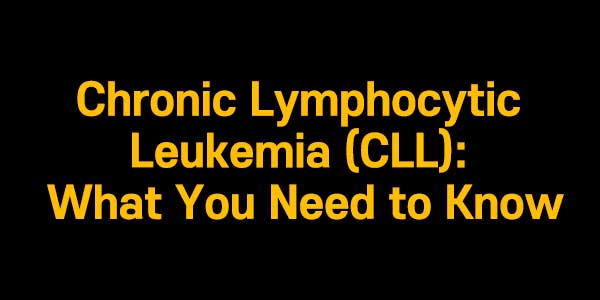
Ever felt fine at your last check-up and then suddenly — boom 💥 — a diagnosis like Chronic Lymphocytic Leukemia (CLL) hits you out of nowhere? You’re not alone.
Hey friends 🖐️ Today we're diving deep into something that affects thousands yet often flies under the radar — Chronic Lymphocytic Leukemia, or CLL. This post is especially for anyone who's just heard the diagnosis, is supporting a loved one, or simply curious. We’ll unpack what it really is, what it feels like to live with it, what helps, what hurts, and how to make life just a bit more manageable. Grab a warm drink ☕, sit back, and let’s get into it — together.
📋 Table of Contents
What Is Chronic Lymphocytic Leukemia? 🤔
Chronic Lymphocytic Leukemia (CLL) is a slow-growing cancer of the blood and bone marrow. It primarily affects a type of white blood cell called B lymphocytes, which are crucial in fighting infections. In people with CLL, these B cells become cancerous, grow uncontrollably, and crowd out healthy cells. What’s tricky is that CLL can be asymptomatic for years — meaning many people don’t know they have it until it’s picked up during routine blood work.
Unlike aggressive leukemias that come on fast and furious, CLL tends to progress more slowly. But don’t let that fool you — it still requires careful monitoring and sometimes treatment depending on your symptoms and disease stage.
Symptoms & Stages of CLL 📊
| Stage | Common Symptoms |
|---|---|
| Early (Stage 0–I) | Often no symptoms; sometimes swollen lymph nodes or slightly high white blood cell count |
| Intermediate (Stage II) | Fatigue, anemia, enlarged spleen or liver |
| Advanced (Stage III–IV) | Severe fatigue, night sweats, weight loss, frequent infections, easy bruising or bleeding |
What Causes CLL? 🧬
Honestly, science hasn’t nailed down one exact cause — but we do know some strong risk factors. Age is a big one: most people diagnosed are over 60. Then there’s family history — if someone in your family has had CLL or another blood cancer, your risk goes up.
Other potential contributors include certain genetic mutations, exposure to herbicides like Agent Orange, and compromised immune systems. It’s not something you “catch” or cause — it just happens, and that unpredictability can be the scariest part.
CLL Treatments & What to Expect 💉
Here’s some good news: not everyone with CLL needs immediate treatment. In early stages, doctors often recommend a "watch and wait" approach with regular blood tests and checkups. But if symptoms start to interfere with your life, there are several treatment options available:
- ✅ Targeted therapy (like BTK inhibitors: ibrutinib, acalabrutinib)
- 💊 Chemotherapy (sometimes combined with immunotherapy)
- 💉 Monoclonal antibodies (like rituximab)
- 🩺 Stem cell transplant (rare, for very aggressive cases)
Side effects vary but can include fatigue, nausea, and increased infection risk. That's why lifestyle habits and diet matter more than ever during treatment. Let’s talk food next!
Foods That Help (and Why) 🥗
| Food | Why It's Good |
|---|---|
| Leafy Greens | Rich in vitamins and antioxidants that support immune function |
| Berries | Packed with anti-inflammatory properties and vitamin C |
| Salmon | Omega-3s to help reduce inflammation |
| Greek Yogurt | High protein + probiotics for gut health during chemo |
What Foods to Avoid 🚫
- ❌ Raw or undercooked meats — infection risk!
- ❌ Unpasteurized dairy products — again, bacteria alert
- ❌ Sugary drinks and junk food — feed inflammation, not you
- ❌ Alcohol — can weaken immune response and interact with meds
When in doubt, go for clean, whole foods and talk with your doctor or a registered dietitian. Every bite counts when you’re in a fight like this 💪
Yes, CLL is a slow-growing blood cancer that originates in the bone marrow and affects white blood cells.
Many people live for years or even decades with CLL, especially when diagnosed early and monitored properly.
CLL progresses slowly and may not need treatment right away, while acute leukemias develop rapidly and require immediate care.
CLL is generally considered treatable but not curable. Many patients manage it as a chronic condition.
Regular exercise, a balanced diet, staying hydrated, and avoiding infections can help improve quality of life.
Yes, especially during active treatment or flu season, as their immune systems are more vulnerable to infections.
Wow, thanks for staying with me all the way to the end 💛 If you or someone you care about is dealing with Chronic Lymphocytic Leukemia, know that you're not walking this path alone. Whether you're just getting started with a diagnosis or knee-deep in treatment, I hope this guide brought you a bit of clarity, hope, and strength. Remember — knowledge is power, and small changes can lead to big transformations. Feel free to share your thoughts, questions, or personal journeys in the comments below. Let’s keep this space supportive and real ✨
CLL, leukemia, blood cancer, chronic lymphocytic leukemia, cancer symptoms, leukemia foods, cancer diet, immune health, chemo tips, health awareness